

Online systems have revolutionized the way companies look at, measure, and manage employee performance. Effective software makes the entire process easier for administration, engaging for employees—and most importantly—frictionless for managers.
But how do you identify which performance management software is best?
Finding the right performance management software provider isn’t a process to take lightly. In this guide, we discuss the benefits, features, and important evaluation considerations for your performance management system.
Let’s dive in:
A performance management system is the collection of processes and tools that enable you to build a culture of growth, drive engagement, and increase employee impact. The right system will equip your leaders with the insights they need to monitor and coach employee performance, create dynamic two-way communication, encourage top-down and peer-to-peer feedback, and much more.
The primary goals of your performance management system include elevating individual and collective performance, aligning your teams with organizational goals, and creating a high-impact workforce.
Certain features within an effective performance management system help leaders stay on top of employee performance to continuously motivate and engage them, which reduces turnover and maximizes business outcomes.
In today's dynamic and fast-evolving business landscape, achieving and sustaining employee success should be top of mind. It's not just about the quantity of work but the quality, innovation, communication, and adaptability that drives higher impact from your employees and teams - leading to organizational excellence.
If you’re still relying on a single annual performance review, you may be missing the mark. Modern organizations require a continuous performance management approach that fosters real-time data collection, ongoing performance conversations, and strategic alignment with business goals.
A cutting-edge performance management system is more than just an evaluation tool; it's the foundation that enables organizations to adapt, improve, and drive performance at all levels.
Now, let’s dive into the top reasons why leaders need a performance management system, and why it’s so crucial in achieving employee success.
Accurate performance measurement is table stakes. But, only 36% of employees say they fully understand their job responsibilities and performance expectations. A performance management system provides clarity, aligning employee efforts with organizational objectives. This clarity is vital for effective performance, as revealed by Lighthouse Research & Advisory.
Many employees crave more feedback and coaching, with 50% desiring additional feedback. A performance management system empowers leaders to bridge skill gaps, equipping employees with the tools they need to grow and succeed.
Clearly articulated individual goals are a powerful engagement driver. Quantum Workplace Research indicates that employees with individual goals are twice as likely to be engaged. Performance management systems facilitate these conversations, aligning personal aspirations with organizational objectives.
Recognition and appreciation matter deeply to employees. Approximately 20% of employees feel regularly recognized and appreciated for their work, and half of employees desire more recognition. A performance management system enables leaders to recognize achievements and efforts which help boost morale and reduce turnover.
Trust is vital in any successful workplace. Effective performance management creates transparency and fairness, building a strong foundation of trust that's essential for strong working relationships. But how do you start to build trust?
It all starts with communication and transparency at every level. Organizations should be actively working to provide employees with open feedback, regular connection with their managers, and visibility into their performance.
Every employee should have a clear path to growth within the organization. Performance management systems incorporate details that bring your talent development to life. The right system helps you shift talent development from an aspiration to a structured process.
Quantum Workplace Research shows that performance management significantly impacts the overall organizational culture. Effective performance management systems align every employee with the broader mission, creating a sense of purpose.
Ultimately, a performance management system is a strategic tool. Brandon Hall Group reveals that 62% of organizations believe their current performance management processes don't enhance performance. A modern system, however, is designed to drive the outcomes that matter most to your business.
Your performance management system should contain four key capabilities: planning, monitoring, reviewing, and rewarding.
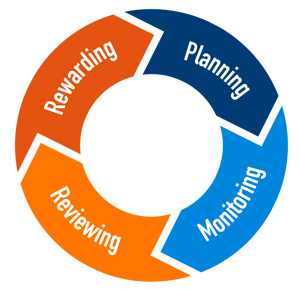
Let’s review each of these capabilities in more detail:
Effective performance management begins with thoughtful planning. Your performance management system should assist in defining and aligning employee goals with organizational objectives. This initial stage provides a critical opportunity for employees, teams, and leaders to set clear expectations and outline actionable plans. By doing so, the system enables organizational alignment and sets the stage for a collaborative effort. It helps everyone understand their role in achieving the organization's mission and provides a structured framework for action.
Monitoring performance is an ongoing process that requires real-time data and insights. A robust performance management system should enable organizations to track key metrics and continuously monitor employee progress toward their goals. This monitoring function serves multiple purposes: it helps identify potential roadblocks early, ensures that employee and team goals remain on track, and provides a foundation for data-driven decision-making. Monitoring is essential for addressing challenges promptly and motivating sustained productivity.
The reviewing phase is where the magic happens in terms of employee development. An effective performance management system should facilitate efficient and meaningful performance reviews. These reviews go beyond simple evaluations; they provide a platform for managers to engage in constructive, two-way conversations with employees. This includes offering feedback, understanding and removing obstacles to success, and collaboratively creating strategies and action items for the future.
But reviews aren’t limited to top-down management. The right system will effectively enable peer-to-peer and cross-team feedback when and where you need it, so you can make sure you’re getting comprehensive view of employee performance.
The system should streamline this process, making it easy for both managers and employees to engage in open and productive dialogues. Your system should also help you document conversations in a meaningful way so you can call up feedback from any time frame.
Recognition is an important element in driving employee motivation and performance. Your performance management system should equip leaders with the tools needed to acknowledge and reward employees for their efforts.
Effective recognition fosters a positive work environment, reinforces desired behaviors, and inspires employees to consistently deliver their best. By providing a platform for leaders to express public appreciation and reward outstanding contributions, the system contributes to a culture of excellence and continuous improvement.
Incorporating these elements into your performance management system ensures that it comprehensively supports the entire performance management cycle, from initial goal setting to performance review to succession planning and employee recognition. This holistic approach not only streamlines the process but also maximizes the potential for employee success and organizational excellence.
Clear, aligned, and shared goals guide employees, ensuring work stays in sync with the organizational strategy. This fosters accountability, motivation, and strategic alignment at all levels.
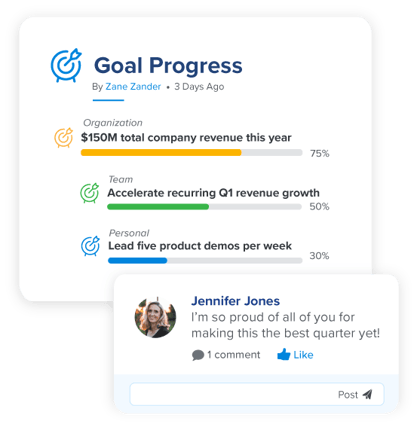
Look for a performance management software that has:
Performance conversations should be frequent, collaborative, and documented. And employee-manager one-on-ones are the perfect opportunity to discuss performance. From check-in meetings to formal performance reviews, one-on-ones might be the most important part of your performance management platform. When managers effectively coach and develop their employees, 74% say their performance management systems are effective.
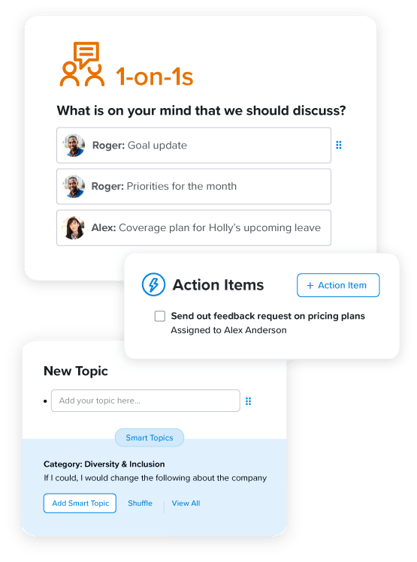
With so many moving parts, it can feel daunting to try to capture the right information, document it, and create an action plan for every single employee, every time.
Your performance management software should empower managers to have regular and effective performance conversations.
Performance reviews should be future-focused, transparent, and two-way. Look for one-on-one software that can help you prepare for and follow-up on meetings with features such as:
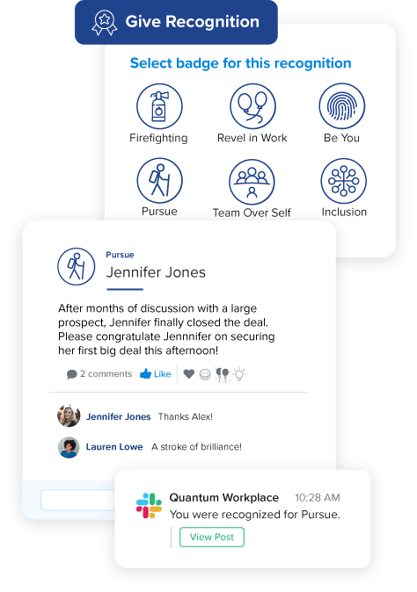
Only 37% of employees nationwide are satisfied with the way they receive recognition and appreciation at work. And a staggering 45% of workers have not been recognized in the last six months.
Recognition software can help you bridge the gap to celebrate, motivate, and engage teams across your organization.
Look for recognition software that has:
Integrated notifications: amplify success stories to Slack and Teams
Great companies are built on trust, and trusting cultures are built on feedback. Our research shows that a strong feedback culture correlates with a highly engaged workplace.
Continuous feedback should be individualized, constructive, and unbiased. Regular feedback from managers and peers builds strong relationships by encouraging transparent dialogue and helps drive better performance through continual improvement.
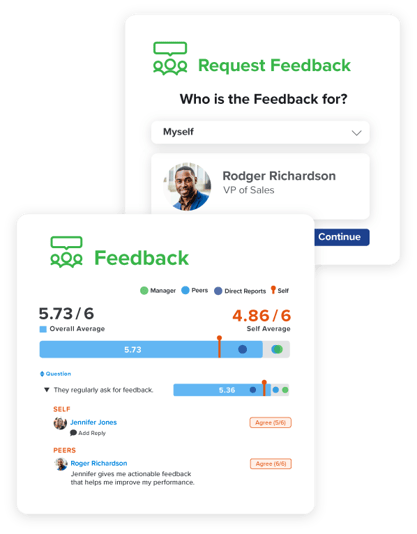
Too many organizations aren’t providing enough feedback. In fact, 71% of employees prefer immediate feedback, even if it’s negative. The right software can make sure your teams are getting the feedback they need to succeed.
Choose a feedback tool that helps you create a feedback culture across the organization.
Look for software that has:
Talent reviews should be frequent, unbiased, and rooted in data. Managers and leaders across the organization need to know who is doing the best work, who is ready for promotion, and who is at risk of leaving. Talent reviews allow leaders to track and evaluate performance, identify and coach performers who need more support, develop and retain top talent, and intervene before employees burn out or quit.
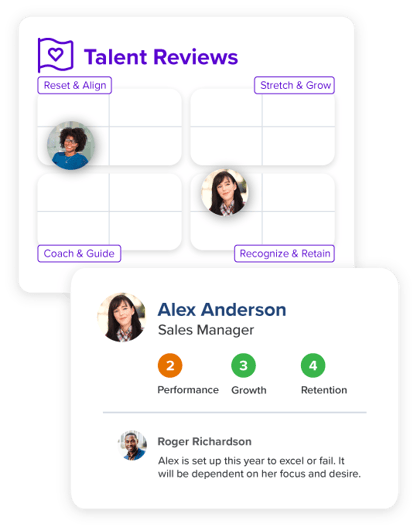
Talent decisions should be based on credible data that is easy to access, understand, and act upon. Performance management software can help you track talent metrics on an ongoing basis so you can make informed and strategic talent decisions.
Look for features that simplify and increase the quality of the talent review process, such as:
Visibility into your company’s critical roles and your company’s talent pool is the first step to creating a board-worthy succession strategy for your organization. Start by outlining the roles that are most important to your business function. The c-suite is a no-brainer, but don’t neglect other critical roles such as information technology, security, and specialized roles. Once you have visibility into your roles, you can create targeted pathways for your talent to gain access to training, mentoring, knowledge sharing, and more.
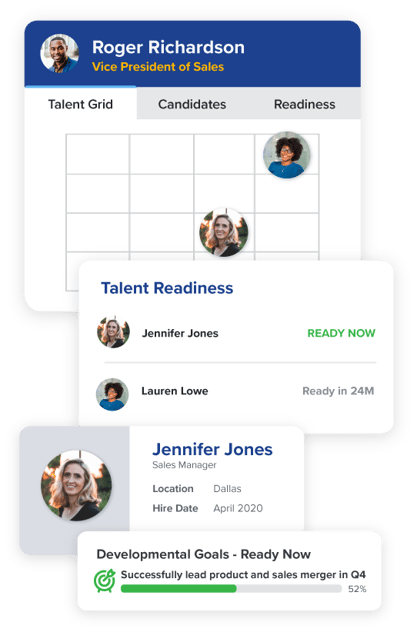
With the right tools, leaders can have actionable reporting on your talent pipeline, readiness, and risk all with just a few clicks. If your performance management system is fully integrated, you’ll be able to quickly understand who your talent leaders are, when they’ll be ready to take on key roles, and where your talent gaps are.
Look for succession planning software that has:
Effective performance management, as a pillar of employee success, aims to nurture a culture of growth, engagement, and excellence. It establishes a strong foundation within your organization, aligns teams with strategic goals, and promotes open communication, feedback, and coaching. By fostering alignment and engagement, it inspires employees to reach their full potential and supports effective team leadership.
An effective performance management system isn’t just about function, features, and tools. The right system should help you capitalize on your larger organizational initiatives. To help you meet your goals, you should look beyond the functionality of your system and make sure you have a strong foundation, scalable goals, quality coaching, and proper alignment within the organization.
In order to get the most value from your system, make sure you have:
In your search for a performance management system, remember that you're not just seeking a solution; you're seeking a partner in your journey to employee success.
Look for a provider who not only offers cutting-edge technology but also understands the unique needs and aspirations of your organization. A true partner will collaborate closely with you to tailor the system to your specific requirements, ensuring it aligns seamlessly with your culture and goals.
This partnership goes beyond implementation; it's about ongoing support, growth, and mutual success, ensuring your performance management system evolves with your organization and continues to drive excellence.
When picking out the right solution for you, there are many things to consider. That’s why we’ve compiled a list of 12 questions you should ask to get the most out of your performance management system.
When first adopting a performance management system, it’s important to understand the why behind your performance initiatives. By doing this, you can uncover the opportunities and obstacles that you want your performance management system to help you navigate. This will help you gain insight into whether your system is the right fit or not.
Effective performance management is essential to driving business success. It includes giving and receiving feedback, holding regular performance reviews, recognizing employees, and more. But juggling all these performance activities is time-consuming—for both managers and employees—and can easily overwhelm leaders, resulting in miscommunication, dropped balls, and frustration all-around.
A performance management system can help leaders organize and prioritize performance management activities to enable better outcomes and aligned actions. But what solution you should choose will depend on why you’re investing in a performance management system.
This will help guide your decision-making and position the business case to other stakeholders.
Similarly, it’s important to consider the specific features and capabilities you’re looking for in a performance management system. Choosing a system with lots of bells and whistles isn’t always the right move if it doesn’t provide the core functions you need to improve performance and streamline your processes.
Consider what your performance management goals and needs are. What do you hope to gain from the software?
This might include:
Assess what processes are working well and identify what needs improvement so you can pick a performance management solution that addresses those gaps and enhances your successes.
As you evaluate your current state of performance management, look for short-term and long-term opportunities to drive business outcomes.
For instance, a performance management system can help you fill obvious gaps in the short-term, such as transitioning from annual reviews to quarterly 1:1s, making employee recognition public, and creating team-based goals to further align employee efforts with the organization.
All of these systems can help organizations understand what performance looks like throughout the year and begin connecting the dots from employee to business success.
But performance management systems can also help you take advantage of long-term opportunities like:
All of these describe a more ongoing, iterative process that allows you to understand, motivate, and coach to higher performance across your organization.
Use these performance management system questions to drill down to the specific software capabilities and features you need and help you choose a system that aligns with your goals.
Make sure the performance management software you're evaluating provides all of the tools your managers need to better serve their teams. Sit down with team leaders and ask what kinds of software they need to fulfill their managerial responsibilities.
The performance management software you choose should be a benefit (not a burden) for managers.
Ideally, your performance management software will provide you with some structure and process. For example, a system could include one-on-one meeting templates and a suggested cadence for meeting. That's great, but make sure the provider you choose allows for some flexibility. Your company's culture is unique and constantly evolving. Choose a performance management software that can fit your needs now and in the future.
Take personalization one step further and find software that lets you customize employee profiles, include images, videos, or gifs in posts and updates, incorporates your company branding, and emulates your core values.
You'd be surprised how common this actually is. If a provider of performance management software doesn’t use their own tools, your company shouldn’t be either. Enough said.
The last thing your managers need are more systems, more passwords, and more hassle. Ask your potential software provider if their tools integrate with other systems your managers use in their everyday workflow, like chat apps for example.
At the very least, your performance management software should integrate with your HRIS so all employee data stays up to date. If your potential provider doesn't have the integration you need, see if they’ll make it happen for you.
Finally, it’s important to evaluate the supporting service behind the software.
The easier it is to implement a program, the easier it will be to get buy-in from managers and employees. Look for a performance management system that is easy-to-use and has strong customer support to train and onboard new users, answer questions, troubleshoot issues, and spur adoption.
The last thing you want to do is invest in performance management software that your managers and employees don't use. Ask potential software providers how they encourage organizational adoption. The best systems will provide admins with log-in and usage stats, give you the ability to nudge users who haven't been active in a while, display recent activity for all employees to see.
But, if we're being honest, none of the above should be needed to drive adoption. The best performance management software will be a seamless no-brainer for managers and an engaging solution for employees, earning adoption all on its own. Ask software providers if they offer a free trial of their performance management system to see if it’s up to snuff for your workforce.
When implementing a new system, you want to know your vendor has your back. Some vendors are only involved with the initial software installment and setup—then they leave it up to you to figure out how to use it, how to communicate the system to your employees, and how to get the most of its capabilities.
This means you’re less likely to enjoy the full value and potential of your new system. Look for a vendor that offers reliable service every step of the way—from sales conversations and new customer calls to implementation plans to coaching support along the way.
When evaluating vendors look for things like:
Any performance management software worth its salt can prove its impact. Make sure your system can measure what's important to you and your leadership team. Ask potential providers if they can show that public recognition makes employees feel valued. Or if transparent goal setting and tracking lead to greater organizational alignment.
Ready to make your performance management process the pillar of employee success? Download our eBook and learn how to build an effective performance management strategy unique to your organization.
Published October 26, 2023 | Written By Natalie Wickham